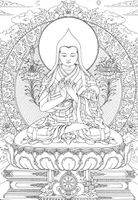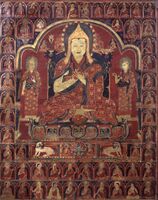Tsong kha pa: Difference between revisions
m (Text replacement - "|Images=" to "|images=") |
No edit summary |
||
| (17 intermediate revisions by 5 users not shown) | |||
| Line 1: | Line 1: | ||
{{Person | {{Person | ||
|MainNamePhon=Tsongkhapa | |||
|MainNameTib=ཙོང་ཁ་པ་ | |||
|MainNameWylie=tsong kha pa | |||
|PersonType=Classical Tibetan Authors | |||
|images=File:Tsongkhapa (R. Beer).jpg{{!}}Line Drawing by Robert Beer Courtesy of [http://www.tibetanart.com/ The Robert Beer Online Galleries] | |||
File:Tsongkhapa HAR.jpg{{!}}Tsongkhapa [https://www.himalayanart.org/items/595 Himalayan Art Resources] | |||
|YearBirth=1357 | |||
|YearDeath=1419 | |||
|BornIn=tsong kha (Amdo) | |||
|BdrcLink=https://www.tbrc.org/#!rid=P64 | |||
|TolLink=http://www.treasuryoflives.org/biographies/view/Tsongkhapa-Lobzang-Drakpa/8986 | |||
|tolExcerpt=Tsongkhapa Lobzang Drakpa was one of the most influential Tibetan Buddhist scholars of the last millennium. Born in Amdo, he travelled to U-Tsang in his youth, never to return to his homeland. In U-Tsang he studied with numerous teachers of all traditions and engaged in many retreats resulting in his development of a fresh interpretation of Nāgārjuna's Madhyamaka view and a reinvigoration of the monastic Vinaya. Widely regarded as an emanation of Mañjuśrī, Tsongkhapa composed eighteen volumes of works of which the majority dealt with tantric subjects. He was the founder of Ganden Monastery, which became the central monastery of the Geluk tradition that was founded on his teachings and writings. | |||
|HarLink=https://www.himalayanart.org/search/set.cfm?setID=197 | |||
|HasDrlPage=Yes | |HasDrlPage=Yes | ||
|HasLibPage=Yes | |HasLibPage=Yes | ||
| Line 5: | Line 18: | ||
|HasDnzPage=Yes | |HasDnzPage=Yes | ||
|HasBnwPage=Yes | |HasBnwPage=Yes | ||
|AltNamesWylie=tsong kha pa blo bzang grags pa; blo bzang grags pa'i dpal; blo bzang grags pa; | |AltNamesWylie=tsong kha pa blo bzang grags pa; blo bzang grags pa'i dpal; blo bzang grags pa; | ||
|AltNamesTib=ཙོང་ཁ་པ་བློ་བཟང་གྲགས་པ་; བློ་བཟང་གྲགས་པའི་དཔལ་; བློ་བཟང་གྲགས་པ་ | |AltNamesTib=ཙོང་ཁ་པ་བློ་བཟང་གྲགས་པ་; བློ་བཟང་གྲགས་པའི་དཔལ་; བློ་བཟང་གྲགས་པ་ | ||
|TibDateGender=Female | |TibDateGender=Female | ||
|TibDateElement=Fire | |TibDateElement=Fire | ||
|TibDateAnimal=Bird | |TibDateAnimal=Bird | ||
|TibDateRabjung=6 | |TibDateRabjung=6 | ||
|ReligiousAffiliation= | |TibDateDeathGender=Female | ||
|StudentOf=bsod nams rgyal mtshan; Red mda' ba gzhon nu blo gros; Nya dbon kun dga' dpal; Phyogs las rnam rgyal; sgra tshad pa rin chen rnam rgyal; Karmapa, 4th | |TibDateDeathElement=Earth | ||
|TeacherOf='gos lo tsA ba gzhon nu dpal; mkhas grub rje; Rgyal tshab rje dar ma rin chen; spyan nga bsod nams bzang po | |TibDateDeathAnimal=Pig | ||
|TibDateDeathRabjung=7 | |||
|ReligiousAffiliation=Geluk | |||
|ClassicalProfAff=Ganden Monastery | |||
|StudentOf=bsod nams rgyal mtshan; Red mda' ba gzhon nu blo gros; Nya dbon kun dga' dpal; Phyogs las rnam rgyal; sgra tshad pa rin chen rnam rgyal; Karmapa, 4th | |||
|TeacherOf='dul 'dzin grags pa rgyal mtshan; 'gos lo tsA ba gzhon nu dpal; 'jam dbyangs chos rje bkra shis dpal ldan; mkhas grub rje; Rgyal tshab rje dar ma rin chen; spyan nga bsod nams bzang po | |||
|BiographicalInfo=*Assumes office 1409 dga' ldan dgon (stag rtse rdzong) | |BiographicalInfo=*Assumes office 1409 dga' ldan dgon (stag rtse rdzong) | ||
| Line 27: | Line 39: | ||
*Final Ordination 1381 yar klung rnam rgyal dgon | *Final Ordination 1381 yar klung rnam rgyal dgon | ||
| | |BnwShortPersonBio=Tsongkhapa Lobzang Drakpa was one of the most influential Tibetan Buddhist scholars of the last millennium. Born in Amdo, he travelled to U-Tsang in his youth, never to return to his homeland. In U-Tsang he studied with numerous teachers of all traditions and engaged in many retreats resulting in his development of a fresh interpretation of Nāgārjuna's Madhyamaka view and a reinvigoration of the monastic Vinaya. Widely regarded as an emanation of Mañjuśrī, Tsongkhapa composed eighteen volumes of works of which the majority dealt with tantric subjects. He was the founder of Ganden Monastery, which became the central monastery of the Geluk tradition that was founded on his teachings and writings. | ||
| | |BuNayDefProvComplex=No | ||
| | |PosWheelTurn=Second Turning | ||
| | |BuNayWheelTurnComplex=No | ||
|PosWheelTurnNotes=Wangchuk quotes mkhas grub rje as stating, "In our system, Jé Rinpoché (rje rin po che, that is, Tsongkhapa) mentions that the ''Uttaratantra'' primarily comments on the meaning of those sutras that are in conformity with the middle-wheel teachings, such as the Tathāgatagarbhasūtra, Samādhirājasūtra, Jnānālokasūtra, Aṅgulimālāsūtra, Śrīmālādevīsūtra, and so forth." [[Wangchuk, Tsering]], ''[[The Uttaratantra in the Land of Snows]]'', p. 89. | |||
|PosYogaMadhya=Madhyamaka | |||
|BuNayYogaMadhyaComplex=No | |||
|PosYogaMadhyaNotes=Note that Wangchuk maintains that he developed this certainty later in his career. | |||
*He quotes his ''Golden Rosary of Excellent Exposition'' as stating that the Mind-Only presentation of buddha-nature as, "the viewpoint explicated in the ''Uttaratantra''." [[Wangchuk, Tsering]], ''[[The Uttaratantra in the Land of Snows]]'', p. 90. | |||
*Though he later quotes his presumably final stance as: "In his ''Illuminating the Thoughts of the Madhyamaka'', Tsongkhapa clearly states, "The great master Asaṅga also did not explain the ''Uttaratantra'' according to the Cittamātra School, rather he explicated it according to the Madhyamaka School." [[Wangchuk, Tsering]], ''[[The Uttaratantra in the Land of Snows]]'', p. 93. | |||
|PosZhenRang=Rangtong | |||
|BuNayZhenRangComplex=No | |||
|BuNayVehiclesComplex=No | |||
|BuNayAnalyticMeditComplex=No | |||
|PosEmptyLumin=Tathāgatagarbha as the Emptiness That is a Non-implicative Negation (without enlightened qualities) | |||
|BuNayEmptyLuminComplex=No | |||
|IsInGyatsa=No | |IsInGyatsa=No | ||
|PosSvataPrasa=Prāsaṅgika (ཐལ་འགྱུར་) | |||
|PosSvataPrasaNotes=Wangchuk cites Tsongkhapa's students and commentators on this issue: | |||
*He quotes mkhas grub rje as stating, "In our system, Jé Rinpoché (rje rin po che that is, Tsongkhapa) mentions that... The content of the Uttaratantra is in conformity with Prāsaṅgika-Madhyamaka." [[Wangchuk, Tsering]], ''[[The Uttaratantra in the Land of Snows]]'', p. 89. | |||
*And later on,, "Similarly, Chöwang Drakpé Pel states, "The All-knowing Jétsün (rje btsun, that is, Tsongkhapa) repeatedly made the roar of a lion amongst an assembly of scholars proclaiming that the ultimate view of the ''Abhisamayālamkāra'' and the ''Uttaratantra'' falls within the system of Prāsaṅgika-Madhyamaka." [[Wangchuk, Tsering]], ''[[The Uttaratantra in the Land of Snows]]'', p. 89. | |||
}} | }} | ||
Latest revision as of 16:24, 7 October 2023
| PersonType | Category:Classical Tibetan Authors |
|---|---|
| MainNamePhon | Tsongkhapa |
| MainNameTib | ཙོང་ཁ་པ་ |
| MainNameWylie | tsong kha pa |
| AltNamesTib | ཙོང་ཁ་པ་བློ་བཟང་གྲགས་པ་ · བློ་བཟང་གྲགས་པའི་དཔལ་ · བློ་བཟང་གྲགས་པ་ |
| AltNamesWylie | tsong kha pa blo bzang grags pa · blo bzang grags pa'i dpal · blo bzang grags pa |
| BiographicalInfo |
|
| YearBirth | 1357 |
| YearDeath | 1419 |
| BornIn | tsong kha (Amdo) |
| TibDateGender | Female |
| TibDateElement | Fire |
| TibDateAnimal | Bird |
| TibDateRabjung | 6 |
| TibDateDeathGender | Female |
| TibDateDeathElement | Earth |
| TibDateDeathAnimal | Pig |
| TibDateDeathRabjung | 7 |
| ReligiousAffiliation | Geluk |
| ClassicalProfAff | Ganden Monastery |
| StudentOf | bsod nams rgyal mtshan · Rendawa Zhönu Lodrö · Nyawön Kunga Pal · Chokle Namgyal · sgra tshad pa rin chen rnam rgyal · Fourth Karmapa Rolpai Dorje |
| TeacherOf | 'dul 'dzin grags pa rgyal mtshan · Gö Lotsāwa Zhönu Pal · Jamyang Chöje Tashi Palden · mkhas grub rje · Gyaltsap Je Dharma Rinchen · spyan nga bsod nams bzang po |
| BDRC | https://www.tbrc.org/#!rid=P64 |
| Treasury of Lives | http://www.treasuryoflives.org/biographies/view/Tsongkhapa-Lobzang-Drakpa/8986 |
| Himalayan Art Resources | https://www.himalayanart.org/search/set.cfm?setID=197 |
| IsInGyatsa | No |
| BnwShortPersonBio | Tsongkhapa Lobzang Drakpa was one of the most influential Tibetan Buddhist scholars of the last millennium. Born in Amdo, he travelled to U-Tsang in his youth, never to return to his homeland. In U-Tsang he studied with numerous teachers of all traditions and engaged in many retreats resulting in his development of a fresh interpretation of Nāgārjuna's Madhyamaka view and a reinvigoration of the monastic Vinaya. Widely regarded as an emanation of Mañjuśrī, Tsongkhapa composed eighteen volumes of works of which the majority dealt with tantric subjects. He was the founder of Ganden Monastery, which became the central monastery of the Geluk tradition that was founded on his teachings and writings. |
| PosWheelTurn | Second Turning |
| PosWheelTurnNotes | Wangchuk quotes mkhas grub rje as stating, "In our system, Jé Rinpoché (rje rin po che, that is, Tsongkhapa) mentions that the Uttaratantra primarily comments on the meaning of those sutras that are in conformity with the middle-wheel teachings, such as the Tathāgatagarbhasūtra, Samādhirājasūtra, Jnānālokasūtra, Aṅgulimālāsūtra, Śrīmālādevīsūtra, and so forth." Wangchuk, Tsering, The Uttaratantra in the Land of Snows, p. 89. |
| PosYogaMadhya | Madhyamaka |
| PosYogaMadhyaNotes | Note that Wangchuk maintains that he developed this certainty later in his career.
|
| PosZhenRang | Rangtong |
| PosEmptyLumin | Tathāgatagarbha as the Emptiness That is a Non-implicative Negation (without enlightened qualities) |
| PosSvataPrasa | Prāsaṅgika (ཐལ་འགྱུར་) |
| PosSvataPrasaNotes | Wangchuk cites Tsongkhapa's students and commentators on this issue:
|
| Other wikis |
If the page does not yet exist on the remote wiki, you can paste the tag |


